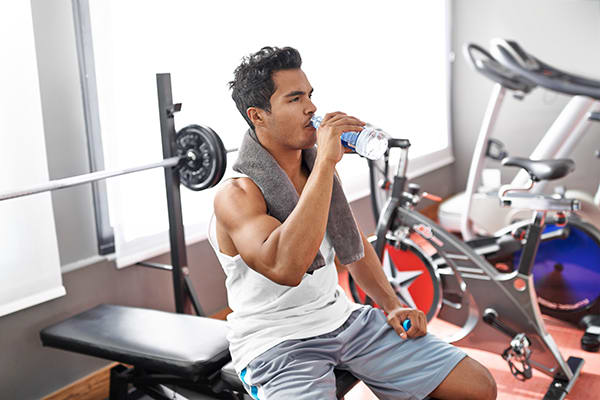5 Tips To Avoid Muscle Soreness

One of the most enduring myths in fitness is that soreness is a sign of a good workout — an indication that you not only crushed it, but that your body is also transforming as a result. The reality, however, is that soreness and workout quality are largely unrelated. Indeed, it likely just means you pushed yourself a little too hard, or that you’re trying something new.
Of course, that reality also makes exercise-induced muscle soreness incredibly normal and exceedingly common. Nearly everyone will experience it at some point on their fitness journey, and many people find it invigorating as long as it doesn’t become debilitating.
That’s where the tips in this article come in. We can’t guarantee they’ll allow you to avoid the dreaded DOMS (delayed onset muscle soreness) monster altogether, but they can help you ditch the “no pain, no gain” mantra for good.
What Is Muscle Soreness?
Intense exercise can cause micro-tears in your muscle tissue, and that leads to delayed onset muscle soreness, or DOMS. This typically develops 12 to 24 hours after a tough workout, and can linger two or three days. The most common symptoms of DOMS include slight swelling, stiffness, and reduced range of motion in the affected joints, and increased tenderness and reduced strength in the affected muscles.
How to Prevent Muscle Soreness:
1. Pick the correct workout program
The more you push yourself, the greater your chances of getting sore. The right program — or a trainer/coach — will ease you into exercise at a pace your body can handle. But, you know, whatever works for your psyche is probably what you’re going to choose. And that’s okay. Just be honest with yourself, and follow the rules below if you know you’re biting off a little more than you can chew.

2. Start SLOW
It’s very tempting to begin an exercise program with a lot of enthusiasm, but try your best to go at a reasonable pace. If you’ve never exercised before, or if it has been a long time since you have, go much easier than you feel you are capable of on day one, and ramp things up based on how you feel after each successive workout. If you’re not sore, go a little harder the next day. If you’re a little sore, take it down a notch. If you’re very sore, then there are some steps you can take to mitigate the soreness.
If you’ve been exercising, but it’s been more than a week since you last worked out, follow the same pattern but go harder based on how fit you are. A good example to use here would be to start with about half of the workout (e.g., the warm-up, cooldown, and one round of exercises). When you have a better fitness base, you can advance a little faster than if you were starting from square one. In general, take about a week to get back to giving 100 percent effort. This is also the example you want to use if you’ve been training and have taken some time off.
If you’ve been exercising, but are starting a new program, base how hard you push yourself on how much advancement there is in your program. For example, if you’ve been doing INSANITY and you’re moving into INSANITY: THE ASYLUM or P90X, you can probably give it your 100 percent (although you might want to be cautious about how much weight you begin with). But if you’re coming into one of those programs from something like 22 Minute Hard Corps or FOCUS T25, you’ll want to back off a bit from what you could achieve on those first few days. Whenever your program makes a big jump in workout duration, intensity, or training style (e.g., from all cardio to all weight training or even a combination of the two) — you’ll want to hold back a bit.
3. Minimize eccentric motion
Concentric movement is the contraction of a muscle, and eccentric movement is the lengthening of it. DOMS is most closely associated with the latter, so if you can limit it, you might also be able to limit post-workout soreness.
If you’re doing a biceps curl, you can slow down the lifting phase of the movement while speeding up the lowering phase, for example. If you’re doing plyometric (i.e., jumping) exercises, you can jump onto a stable surface (e.g., a box or bench) and then step down instead of jumping up and down on the floor.
A lot of very popular exercise programs actually target jumping and eccentric movements. That’s because they’re highly effective tools for building power and athleticism — if your body is fit enough to handle them, which it never will be unless you proceed slowly (see tip #2) and carefully.
4. Hydrate
Dehydration plays a huge role in muscle soreness. Most people are chronically dehydrated. You can actually get sore even if you don’t exercise simply by being dehydrated. And adding exercise increases your water needs. A lot.
How much water you need varies depending on your activity level, lifestyle, where you live, etc., but an easy way to gauge it is to drink half your body weight in ounces each day. But that’s before you account for exercise. For each hour you work out, you should add another 32 ounces (on average). This, too, varies based on the individual, heat, humidity, exercise intensity, and so forth. But you get the idea — you need a lot of water for optimal performance.

Water isn’t the only factor in hydration. Electrolytes are also sweated out when you exercise and must be replaced. If you’re training less than an hour per day, you probably don’t need to worry about them unless your diet is very low in sodium. But if you are working up a sweat for an hour or more, it’s a good idea to supplement with something like Beachbody Performance Hydrate, which can help maximize fluid absorption with an optimal balance of carbohydrates and electrolytes to replace what your body loses during intense exercise.
Drinking too much water can lead to a condition called hyponatremia, in which your electrolyte levels drop to dangerously low levels. While potentially deadly, it’s also very hard for normal humans to experience in everyday circumstances. That’s because you would have to drink excessive amounts of water, have very little salt, and sweat profusely for a long time. So while it’s a very real danger for, say, athletes competing in IRONMAN triathlons, it’s not a relevant concern for most of us.
5. Feed your muscles
Unlike fats and carbs, protein isn’t stored by the body, so if you haven’t had a protein-rich meal within a few hours of working out, have a protein shake afterward. Doing so will ensure two things: First, that the balance of muscle breakdown and growth is shifted heavily toward the latter, and second, that your muscles have all the nutrients they need to optimize their repair and growth processes.
If your shaker bottle is filled with Beachbody Performance Recover, you get another advantage: pomegranate extract, which a study at the University of Austin, in Texas, found to reduce exercise-induced muscle soreness by an average of 25 percent.
What Happens If You Do Get Sore?
No matter how diligent we are, we all seem to mess this up, somehow, sometimes. Depending upon how much you skewed it, you can be back at full strength within a few days. Occasionally, you’ll go way beyond what you should have done. In such cases, you can be out up to a couple of weeks. When this happens, there are a few steps you can take to reduce muscle soreness. Stretching and massaging your muscles are two ways to get on the fast track to recovery. Check out our other tips to help you relieve sore muscles and get back to your workouts feeling better than ever.
